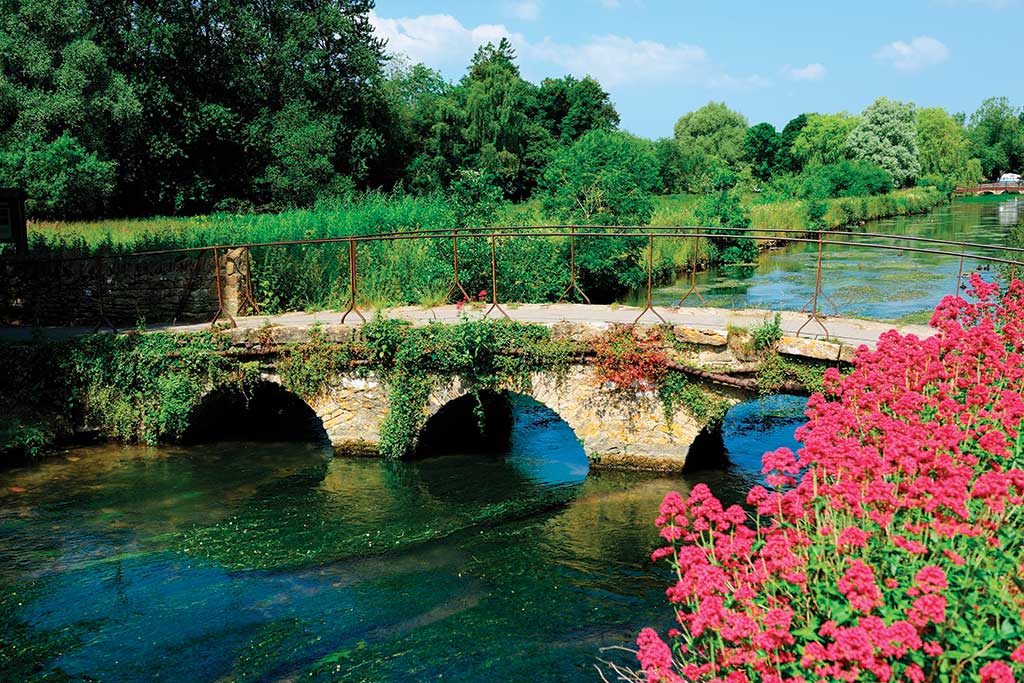Bangers and mash. Bubble and squeak. They sound like theme nights at your favorite dance club, but for many years these traditional English dishes were about as much as we could expect from across the pond. Oh, how things have changed. Innovative chefs are reinventing old favorites as “comeback cuisine” while England’s food culture continues to take on an international flair.
The same can be said for cocktails. Sure, a traditional English ale can be found at nearly every pub you enter, but now you’re also likely to find up-and-coming craft beers and riffs on England’s signature spirit: gin.
I recently road-tripped throughout South West England on a quest to discover the region’s best bites. Venturing beyond London, I switch- backed my way through the countryside, hit the maritime city of Bristol, and eventually landed in a charming fishing village in Cornwall. One thing is for certain: I didn’t go hungry.
THE COTSWOLDS
Head due west of London and you’ll enter the rolling hills (or “wolds”) of the Cotswolds, five counties dotted with charming villages, picture-perfect landscapes, and a crop of eateries both old and new that showcase the region’s bounty.

Kings Head Hotel
My first stop is in Cirencester, a quaint town with roots dating back to the Romans. Over time, the village became a hub for wool production, but two smallpox epidemics nearly decimated the population. Everyone loves a comeback, though, and Cirencester is now a popular (yet not overcrowded) tourist destination. Visitors from near and far come to explore local attractions such as the Corinium Museum, which features Roman artifacts and mosaics, as well as New Brewery Arts, a gallery and studio space housed in a former brewery. But, alas…no beer! Fortunately my local lodging can accommodate.
The Kings Head Hotel (24 Market Place. Tel: +44-128-570-0900. www.kingshead-hotel.co.uk) is a boutique hotel with a history that dates back to the 16th century. While it’s fun to explore the property’s nooks and crannies, which includes a secluded vault that hosts various music events and other live entertainment, a visit to the bar and restaurant offers my first taste of South West England.
The menu, overseen by Executive Head Chef Russell Hunt, is a terrific introduction to classic British cuisine. Putting my cholesterol intake temporarily aside, I begin with a Scotch egg (typically hard-boiled) that is then wrapped in sausage, coated in breadcrumbs, and deep-fried. Kings Head plays with tradition by using a duck’s egg cooked medium (runny yolk), enveloped in black pudding, and served with a homemade salad cream. Main courses embrace locally sourced ingredients like a tasting of Gloucestershire Old Spot pork, which includes rack, belly, and brawn croquette, served with savoy cabbage and bacon puree, and cider jus. Another delicious plating is Creedy Carver duck, sourced from the 82-acre Merrifield Farm in the Devonshire countryside. The plating includes both breast and duck confit, accompanied by a carrot and caraway purée, fondant potato, heritage beetroot, and a juniper berry sauce that offers a nod to sloe gin.
Speaking of gin, after an evening exploring local shops such as Steamer Trading Cookshop (2-4 Dyer St. Tel: +44-128-565-9461. www.steamer.co.uk/locations/cirencester), a well-stocked cookware shop with top- of-the-line products such as Mauviel pots and pans, I return to the hotel for a nightcap. My room is outfitted with the makings for the perfect gin and tonic: Siblings Gin (Keynsham Works. Tel: +44-788-212-5969. www.siblingdistillery.com) and Fever Tree tonic. The gin hails from nearby Cheltenham and is uniquely made in a glass and stainless steel distillery, offering soft vanilla notes in addition to traditional botanicals.
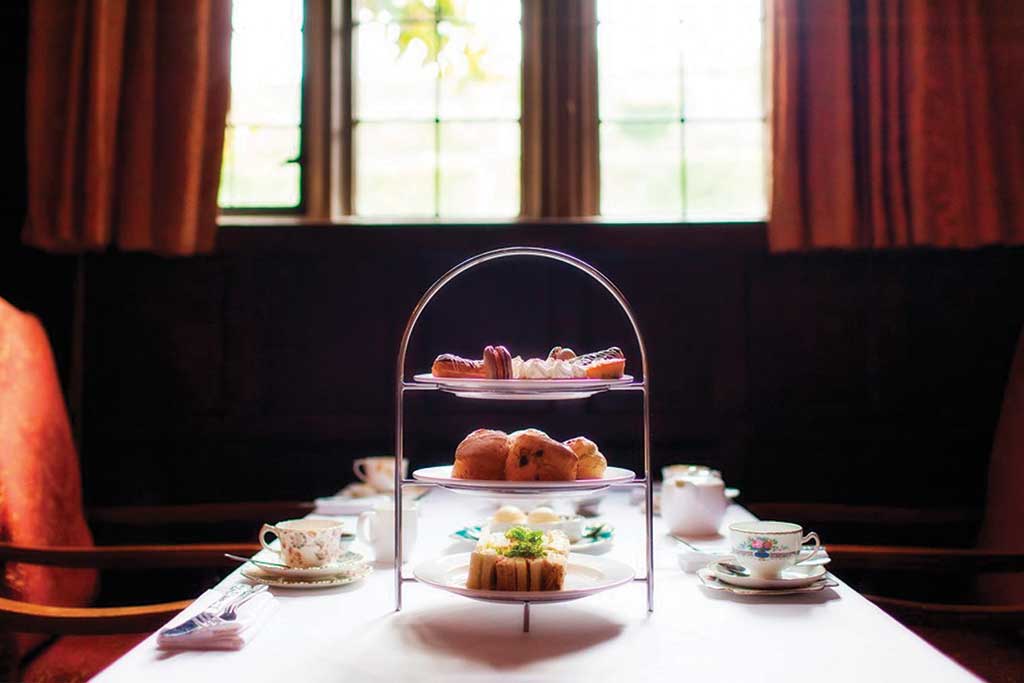

Thornbury Castle
The next day. I venture on to another bucolic Cotswold town: Tetbury. Much like Cirencester, Tetbury was a thriving village in the 17th century due to its prominence in the wool trade. Today, Tetbury is dotted with antique stores, bakeries, and other gastronomic delights. One of the village’s newer arrivals is The Royal Oak (1 Cirencester Rd. Tel: +44-166- 650-0021. www.theroyaloaktetbury.co.uk). Opened in late 2013, owners Chris York and Kate Lewis lovingly restored the property, which includes six en suite guest rooms and an intimate saloon that draws both locals and tourists alike.
“There’s a bit more steel to us, an edge,” says Lewis. “[Tetbury] may look conservative, but you get tradespeople, carpenters, antique dealers, and more. There’s a sense of community here that’s perhaps more experimental than other places.”
The Royal Oak’s menu is veggie-forward, thanks to Lewis’s passion for vegan cuisine. My late-spring visit is the ideal time to indulge in a warm root vegetable salad composed of carrot, celeriac and butternut squash purée, parsnip crisps, lamb’s lettuce, and rosemary vinaigrette. I can’t resist some of the more traditional items, such as pea soup with a heel of crusty bread. And in the spirit of the tradesmen who for centuries have kept Tetbury chugging along, The Royal Oak offers “The Worker’s Pot”—a cast iron one-dish meal (think hearty stew) served with house- made bread for a mere £7.
Heartily fed, I wander the charming streets and discover takeaways that make me grateful I’ve left room in my luggage. For home goods with royal flair, there’s no better destination than The Highgrove Shop (10 Long St. Tel: +44-845-521-4342. www.highgrovegardens.com), where all profits are donated to The Prince of Wales’ Charitable Foundation. Here you’ll find Highgrove teas, confectionaries, preserves, and a charming array of hand-stitched kitchen linens designed by a graduate of The Prince’s School of Traditional Arts.
I can’t help but follow the smell of freshly-baked bread to nearby Hobbs House Bakery (18-20 Church St. Tel: +44-166-650-4533. www.hobbshousebakery.co.uk). The Tetbury location (one of four scattered throughout the Cotswolds) is an ideal spot to gaze out of the box windows and nibble on a hunk of crusty fig and walnut bread or eggy brioche, which rises for an astonishing 16 hours and is deliciously toasted with a slather of lemon curd.
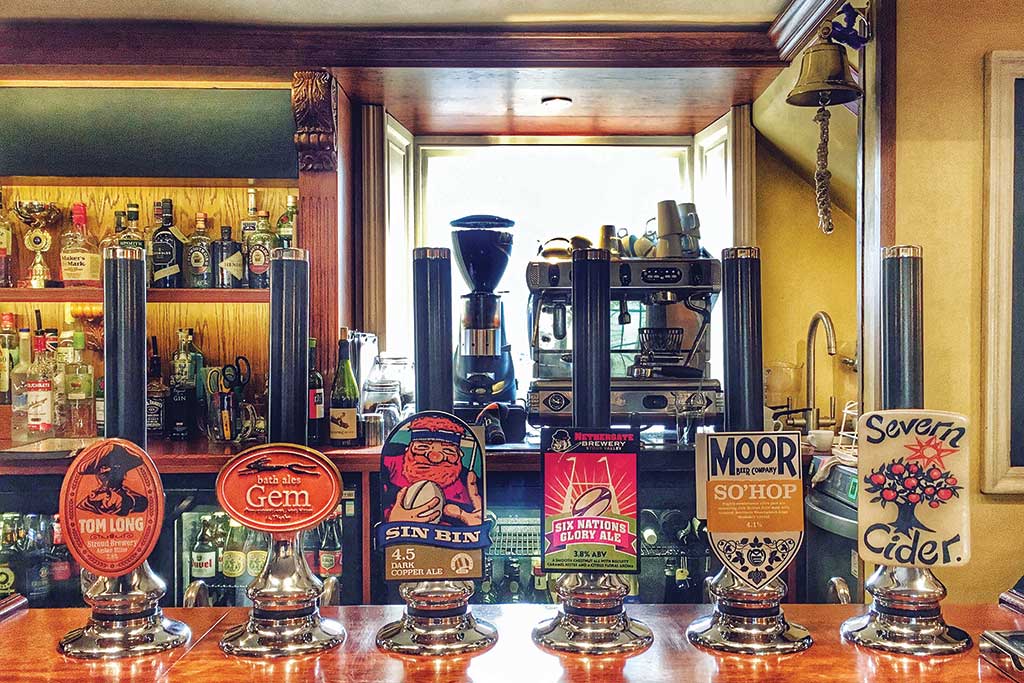

The Royal Oak
LIVING LIKE ROYALTY
Leaving the Cotswolds and heading west toward the River Severn, which spills into the Bristol Channel, I have my eyes on some royal digs at Thornbury Castle (Castle St. Tel: +44-145-428-1182. www.thornburycastle.co.uk). Built by Edward Stafford, Duke of Buckingham, Thornbury Castle has seen its share of trials and tribulations. Stafford was executed for high treason shortly after the castle was finished (note to self: be nice to your servants or they may betray you). Henry VIII claimed the property and paid a visit during his honeymoon tour with Anne Boleyn (who in 1536 also found her head on the chopping block). The castle was eventually returned to the Duke’s descendants but fell into disrepair until the 1850s.
Today, Thornbury Castle is a luxurious hotel that pays homage to its royal splendor while offering a 21st-century experience complete with Wi-Fi, so that you can brag about your stay via social media. My jaw drops as I step into my bedchamber. The room is decked out from floor to ceiling with brocade and tapestries, and though there’s not much light that shines through the deep-walled windows, the regal purple and gold fabrics shimmer, casting a warm hue on a sherry-filled decanter.
I meander the castle grounds that include the oldest Tudor-style garden in England and 14 surrounding acres that offer archery, falconry, and croquet, if you like to party like your predecessors. I scale the 77 circular steps to the tower bedchamber for a peek at Henry VIII’s ten-foot-wide bed and views that capture Gloucestershire’s rolling landscape, grateful that I resisted the complementary sherry until after descending.
The castle’s culinary prowess is as rich as its original occupants. The kitchen garden has been a source of vegetables, fruits, and edible flowers for centuries, all seamlessly integrated into a modern menu overseen by head chef Stuart Shaw and sommelier Manuel Ribeiro.
The pre-fixe menu is a decadent exploration of land and sea. I opt for the seared Orkney scallops (a buttery, sweet scallop typically found around Scotland and the North Sea), paired with Stornoway black pudding (also a Scottish product), cider dressing, and pickled shallots. I also can’t resist a taste of my dining companion’s foie gras torchon. Translated from French, torchon means “dish towel,” referring to the original method of wrapping the fattened duck liver for its long cooking process. Modern methods use cheesecloth but there’s still no rushing this delicate process, which yields a full-bodied and buttery texture, here served with rhubarb, golden beetroot, Sauternes jelly, and plenty of toasted brioche. I can’t resist another chef’s interpretation of Old Spot pork, and chef Shaw prepares belly and cheek in two different methods, accompanied by carrot and cardamom purée, spiced lentils, and a five spice jus for exotic flair. Desserts lean toward the classics, such as panna cotta, molten chocolate cake, or a cheese plate accompanied by biscuits, fruits, and chutneys.


The Bar at Kings Head
In my continued quest for England’s best gin, I make arrangements to tour nearby distiller Bramley & Gage (Asheville Park, Short Way. Tel: +44- 145-441-8046. www.bramleyandgage.com). It was the mid 1980s when Edward Bramley Kain and Penelope Gage began making liqueurs with fruits grown on their South Devon farm. This quickly morphed into Bramley’s Sloe Gin, a gin infused with sloe (similar to a plum). Their children Michael and Felicity now oversee the business, including B&G’s signature product: 6 O’Clock Gin (lovingly named after the distiller’s great grandfa- ther, who enjoyed his gin and tonic at 6 o’clock each evening).
The custom-built copper still produces a clean and crisp gin, with notes of juniper, elderflower, and citrus. Currently unavailable in the US, I stock up on not only gin but quirky spirits like Greengage liqueur, made from fruit grown in the nearby Cotswolds; sweet vermouth with aromatic notes of thyme and rosemary grown nearby; and 6 O’Clock Damson gin, made with local damsons and yielding a deep purple-hued spirit.
CITY LIVING
After a few nights in the countryside, I’m ready for some urban energy and head to the maritime city of Bristol and Brooks Guesthouse (St. Nicholas St. Tel: +44-117-930-0066. www.brooksguesthousebristol.com), a charming bed-and-breakfast located adjacent to St. Nicholas Market, where you can find some of the best cheap eats in the city. Dating back to 1753 and packed with more than 50 vendors such as the Bristol Sausage Shop and Ahh Toots cakery and biscuitier, the market is a great place to grab an inexpensive lunch before wandering the pedestrian-friendly city to scope out its famous street art. Banksy is perhaps Bristol’s most famous and elusive graffiti artist, but a walk among the city streets reveals plenty of can-wielding artists making their mark. A street art tour with Where the Wall (Tel: +44- 774-863-2663. www.wherethewall.com) helps take out the guesswork.
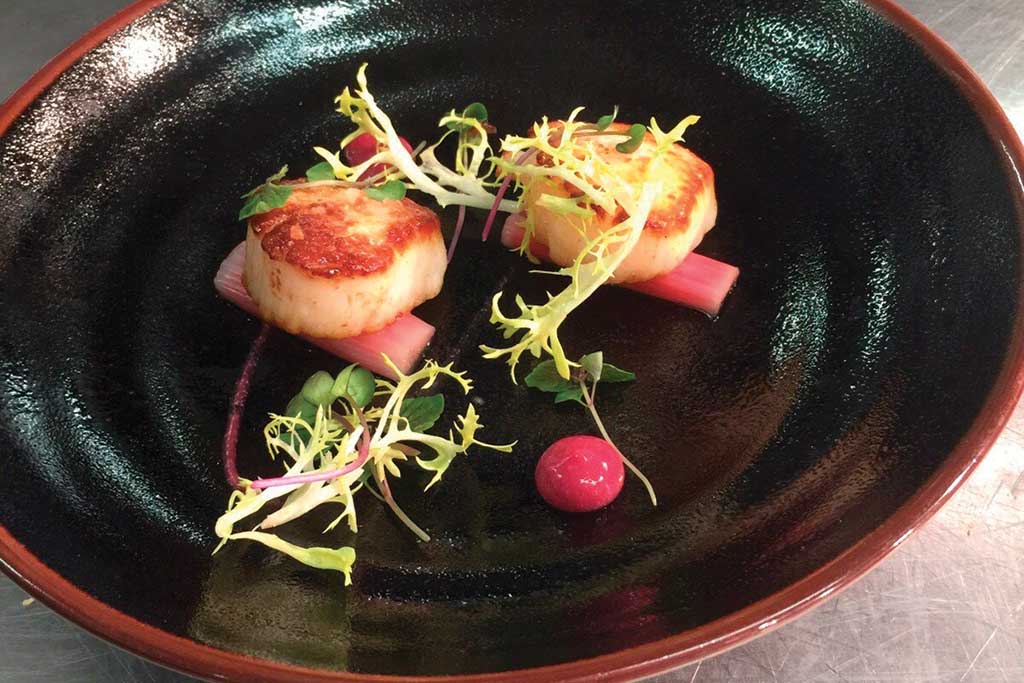

Pan-Fried Scallops With Rhubarb at Kings Head
I also receive a tip from a local and discover The Milk Thistle, one of the city’s most popular craft cocktail lounges. Opened by the same team that launched Hyde & Co. (another swanky spot worth adding to your Bristol agenda), it’s considered “the flirty younger sister” and offers an ever-chang- ing menu of classics and spontaneous concoctions.
I opt for “The Long Walk Home”—an intoxicating blend of Somerset cider brandy, oloroso sherry, demerara sugar, and chocolate bitters. The brandy, sourced from an orchard about 90 minutes south of Bristol, is made from a variety of vintage cider apples with names like Kingston Black and Stoke Red. This attention to detail produces a complex brandy that delivers the foundation for a decadent cocktail. I have two. And then things take a turn as my intoxication, not from the cocktails but from the whimsical Alice in Wonder- land-like setting, encourages that precarious third round. I’m drawn to Queen Liz (a cheeky nod to the monarchy), a blend of Milk Thistle proprietary gin, green chartreuse, cynar amaro, Angostura bitters, and a dash of Pernod absinthe. Wildly herbaceous and with a kick of fennel notes, I’m swept into a cacophony of cocktailing but pull the plug for a good night’s sleep.
Since I’m road tripping, I opt to spend the night in Brooks’ rooftop “trail- er park” comprising four Retro Rockets. Built in Great Britain, the alu- minum caravans are outfitted with compact modern amenities and offer stellar city views. A storm rolls in off the Bristol Channel. Rain pelts hard against the metal roof, but I’m lulled to sleep by the swirl of Milk Thistle’s well-shaken libations.
A DIP IN BATH
Bath has been home to therapeutic waters for centuries, dating back to the Romans. Londoners and other English elites migrated to Bath for holiday during the 18th century and today Bath is an endearing combi- nation of old and new.
I opt for a brief respite from my culinary adventure to do as the Romans did: bathe. And there’s no place more picturesque than Thermae Bath Spa. Four natural thermal baths, including an open-air rooftop pool with city views, provide the backdrop for a day of decadence. I wander among the co- ed steam rooms and pools, taking in the historic Georgian architecture juxtaposed against state-of-the-art design by Sir Nicholas Grimshaw & Partners. The New Royal Bath’s glass enclosure is a standout among the city’s architecture and a top attraction for locals and visitors alike.
After hours of detoxing in the healing waters, I head to a Bath classic: Sally Lunn’s (4 North Parade Passage. Tel: +44-122-546-1634. www.sallylunns.co.uk). Known for the Sally Lunn bun (a yeasty, slightly sweet brioche that’s typically split and slathered with butter), the bun is named after a 17th- century French kitchen worker, Solange Luyon, who was dubbed Sally Lunn when her co-workers couldn’t pronounce her name in French. I order mine with a bowl of piping-hot split pea soup. You will catch the double entendre of the restaurant’s whimsical “top and bottom” bun etiquette (tops for sweet dishes, bottoms for savory), but the end result is delicious either way. Entering the historical building, expect to feel like you’ve walked into Miss Havisham’s attic from Charles Dickens’ Great Expectations. You’ll discover décor inspired by the 1600s to the 1800s, handmade wallpaper, a dusty museum in the basement, along with a slew of tourists brandishing selfie-sticks. But the bun is worth it.
After wandering the city streets at dusk, I enjoy a bit of down time at The Francis Hotel (Queen Square. Tel: +44-122-542-4105. www.francishotel.com). Dating back to 1858, the property consists of a series of connected townhouses and a reconstruction after the hotel was bombed during World War II. Deeply saturated walls in jewel tones of purple, garnet, and navy play off of whimsical illustrations and other fine details. Its pristine location on centrally located Queen Square is just a short jaunt from my evening cocktail.
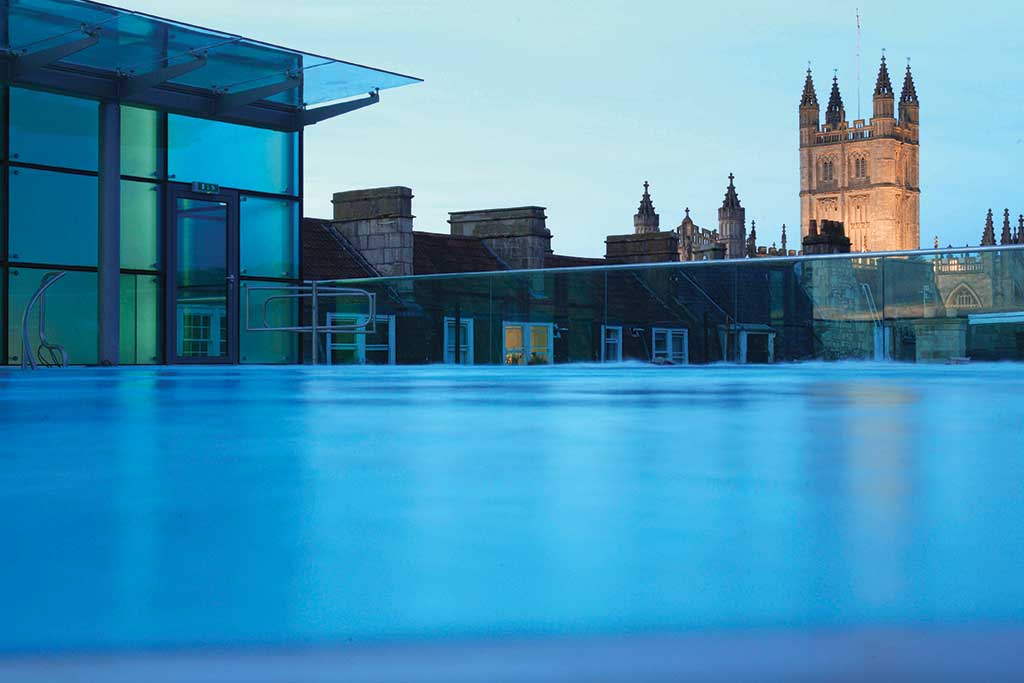

Rooftop Pool at the Thermae Bath Spa
After popping into the Jane Austen Centre (40 Gay Street. Tel: +44-122-544-3000. www.janeausten.co.uk), a must for Anglophiles or anyone with a penchant for late 17th-century/early 18th-century romance novels, I find it fitting to cap off my night at The Canary Gin Bar (2/3 Queen Street. www.thebathgincompany.co.uk), a hole-in-the-wall pub stirring up some of South West England’s most artisan gin concoctions under the watchful eye of mixologist Tom Pople. Most of them feature the bar’s signature Bath gin, a premium, small batch gin that uses wormwood and Kaffir lime leaves among its botanicals to deliver a particularly aromatic gin, packaged with a winking Jane Austen on the label. I sip away at a Jane’s Garden, a refresh- ing combination of Bath gin, elderflower liqueur, cucumber, apple, lemon, and fennel bitters. The vegetal quality is almost like having dinner! But I skip real food in favor of Jane’s Last Word, a variation on the classic “Last Word” cocktail featuring Bath gin, green chartreuse, fresh lime, and Maraschino liqueur. It turns out she does have the last word and I’m in bed before midnight as I prepare for the last leg of my adventure.
I head southwest to the county of Cornwall and the grand finale of my culinary adventure: a visit to Rick Stein’s Padstow Seafood School (River- side. Tel: +44-184-153-2700. www.rickstein.com/school). Most Americans might not be familiar with Stein, but he’s been a mainstay of England’s culinary scene for more than 40 years. Author of 20 cookbooks and 12 tele- vision series, Stein has also been instrumental in bringing a global influence to modern English cuisine. Under the watchful eye of Head Chef Mark Puckey, I try my hand at one of Stein’s legendary recipes, Indonesian seafood curry.
I begin by preparing a traditional spice paste called basa gede, a punchy blend of ginger, nuts, lemongrass, chilis, palm sugar, turmeric, shrimp paste, garlic, and a few other random pantry ingredients. The blender whizzes it all together at a high velocity, releasing aromatics unlike any- thing I’ve ever smelled. I’m then tasked with cleaning the day’s catch, which includes monkfish, squid, and prawns. I wield my fish knife with varying degrees of deftness, though I’m sure Chef Puckey is raising an eyebrow when I’m not looking. Once cleaned, the curry comes together with more lemongrass, lime leaves, a heavy pour of coconut milk, and a squeeze of lime juice for brightness. Served atop long grain rice, I devour the result of my efforts with a smile of accomplishment.
For my final evening, I drive farther south to St. Mawes, a tiny fishing village on the Roseland Peninsula. My room at the St. Mawes Hotel (1 Commercial Road. Tel: +44-132-627-0266. www.stmaweshotel.com) overlooks the water, while the light din of pedestrians below reminds me how far I’ve come on this journey. St. Mawes is famous for its fish pie and Cornish crab—I voraciously eat both in spite of still brimming from my Indonesian curry earlier in the day.
The following day, with a few hours left before beginning the long drive back to Heathrow Airport, I walk in the village for farewell fish and chips, a dish that seemed to escape me throughout the week. As I prop the newspaper-wrapped filet at just the right angle to catch the late-morning sun, a thrifty pelican swoops in to take a bite, leaving behind only shreds of the steaming fish and a side of untouched chips. I take this as a sign that perhaps I’ve eaten enough on this particular journey through South West England, but I know the first thing I’ll order on my next visit.


